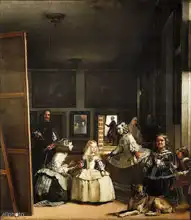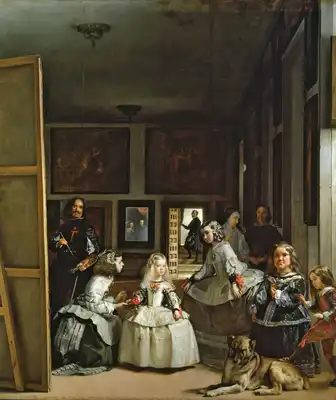About this finishing
Print. The image is printed on the top quality 10-ink HP Z9PS printer on HP matte 270 g / m2 paper. You can choose any size to an accuracy of 1 cm. A margin of 5 cm around the image is added to the size of the motif.


You can find a detailed description about our finishings
here.
Family of Philip IV.
Date:
1656Medium:
oil on canvasLocation:
Prado, Madrid, SpainDimensions:
316 x 276A painting also known as Court Ladies. Probably Velázquez's most famous work. The scene is from his studio in the palace. At the very back of the door is the Royal Upholsterer (Velázquez's namesake). The mirror next to the door reflects the portraits of Philip IV. and Queen Anne. The painter himself is standing in front of the canvas. In the center of the canvas is the little princess Margarita with two ladies-in-waiting (called meninas, a term from Portuguese). One of them (Maria Augustina Sarmiento) hands the princess a silver plate. The second court lady is Isabel de Velasco, next to her is a dwarf of German origin, Mariabárbara. The woman in the white dress in the background is Marcel de Ullo's guardian of the ladies. The composition divides the figures into a group, in the center of the picture is Princess Margarita. The perspective and work with light, which gives depth to the image, is perfect. The picture was painted for the summer rooms of Madrid's Alcázar.
Velazquez painted picture Family of Philip IV. in 1656. Prevailing color of this fine art print is dark and its shape is portrait. Original size is 316 x 276. This art piece is located in Prado, Madrid, Spain. This image is printed on demand - you can choose material, size and finishing.
Diego Velázquez (1599-1660). Spanish
Baroque painter, whose work significantly influenced the history of art. He painted mainly still lifes with figures, portraits and religious motifs. He used colour in an unusual breadth, carefully selected supporting characters in his paintings and no less carefully painted the details of interiors. An important element of his work is the atmosphere of his paintings. He painted realistically and without an idealist perversion of reality.

